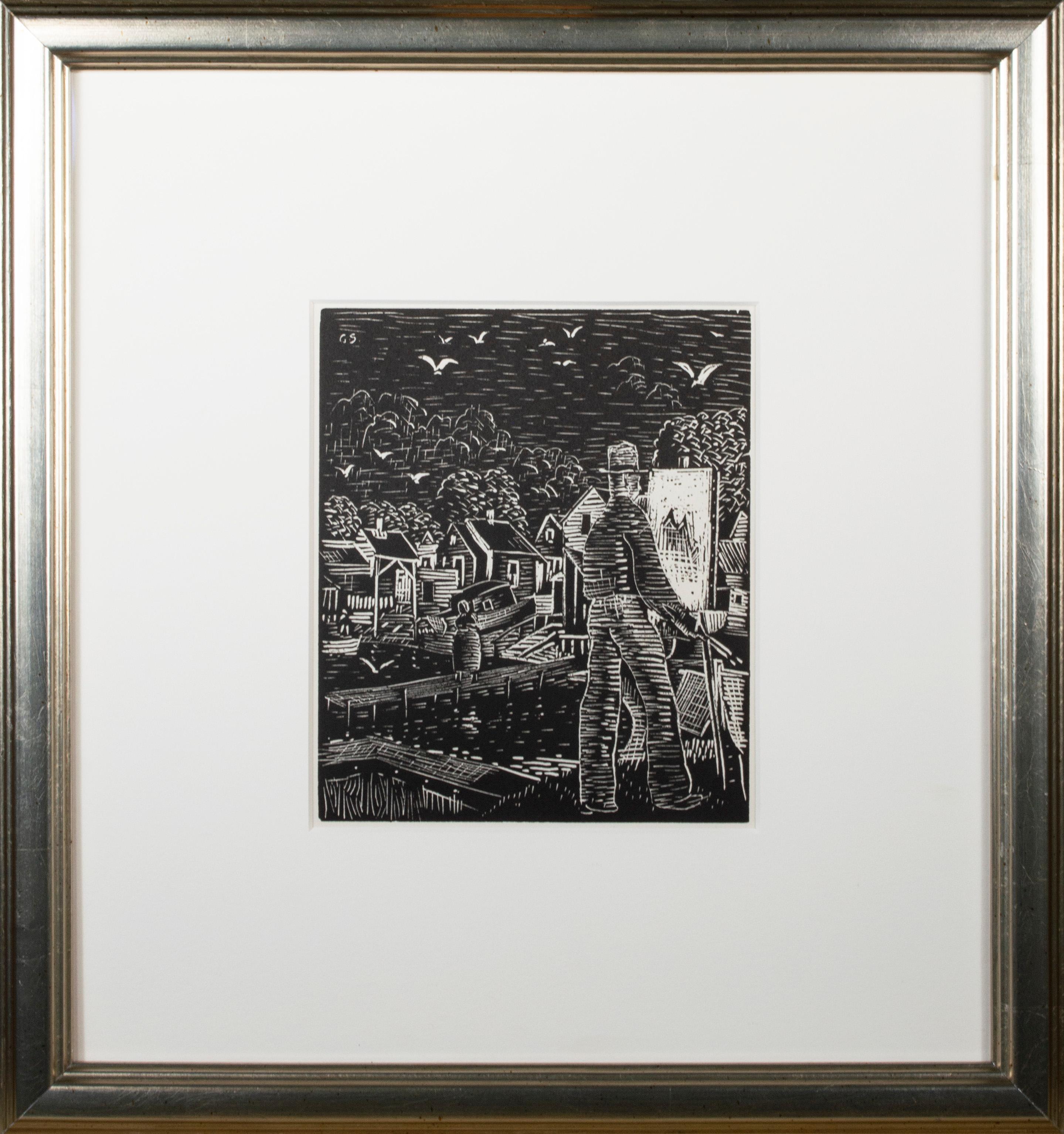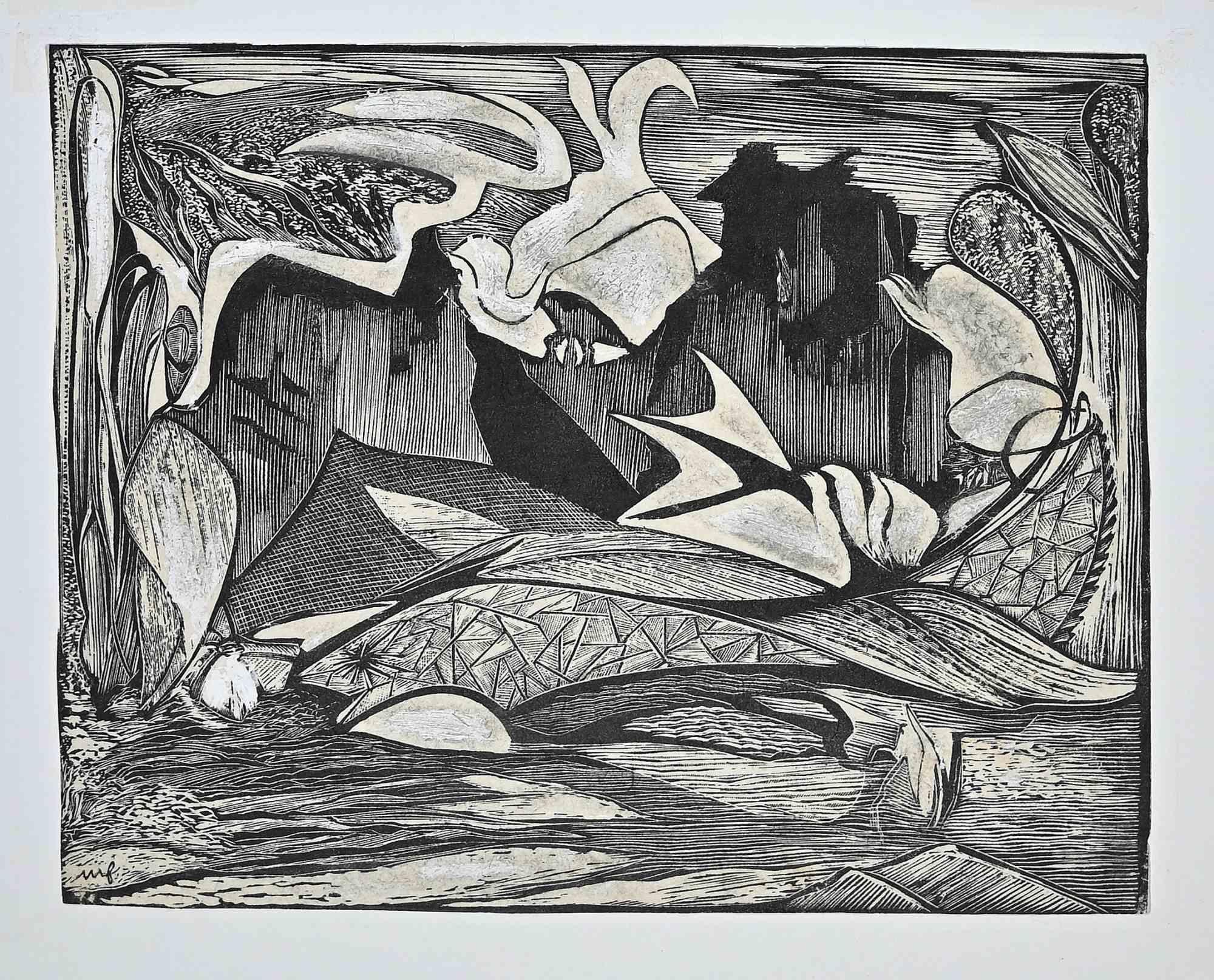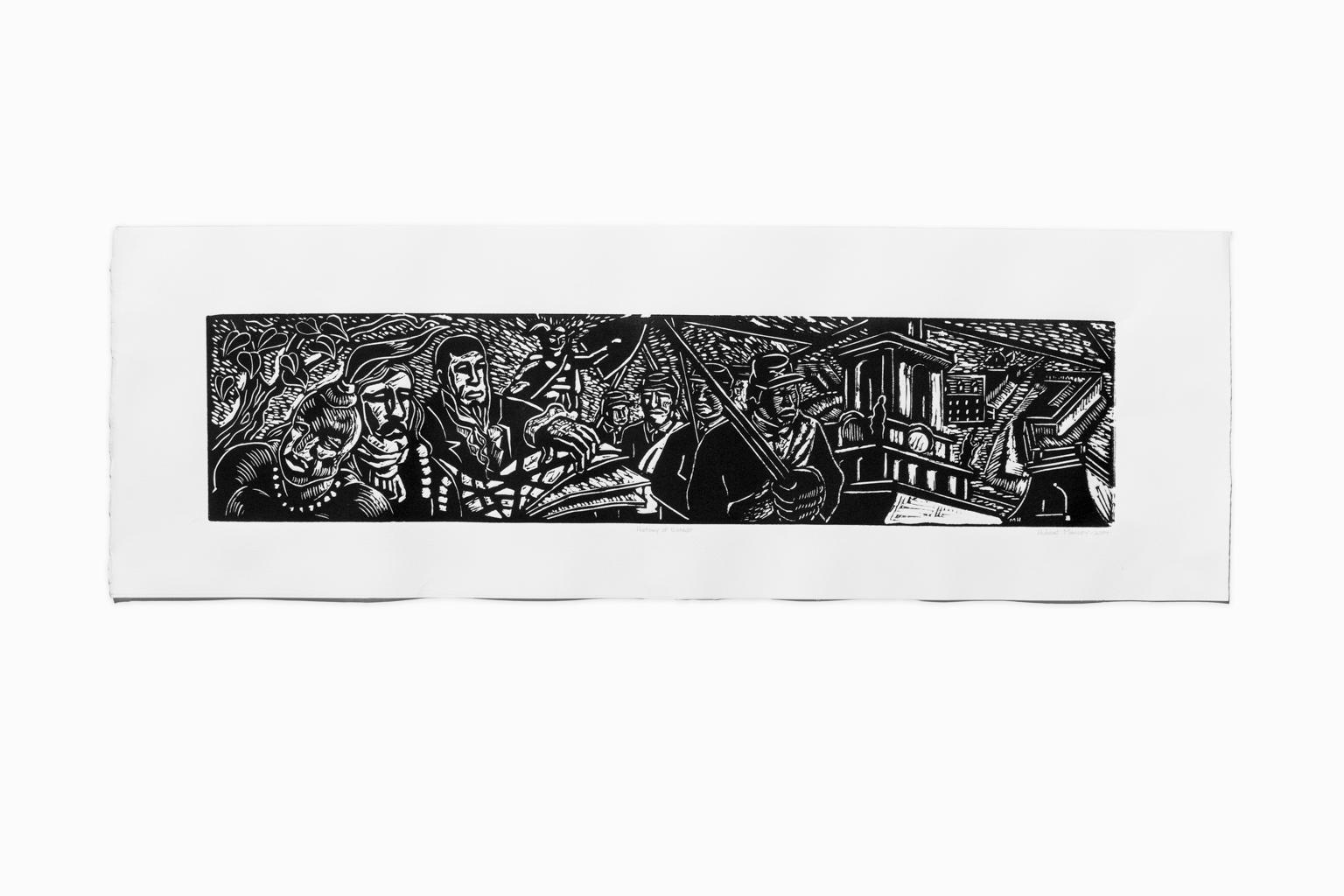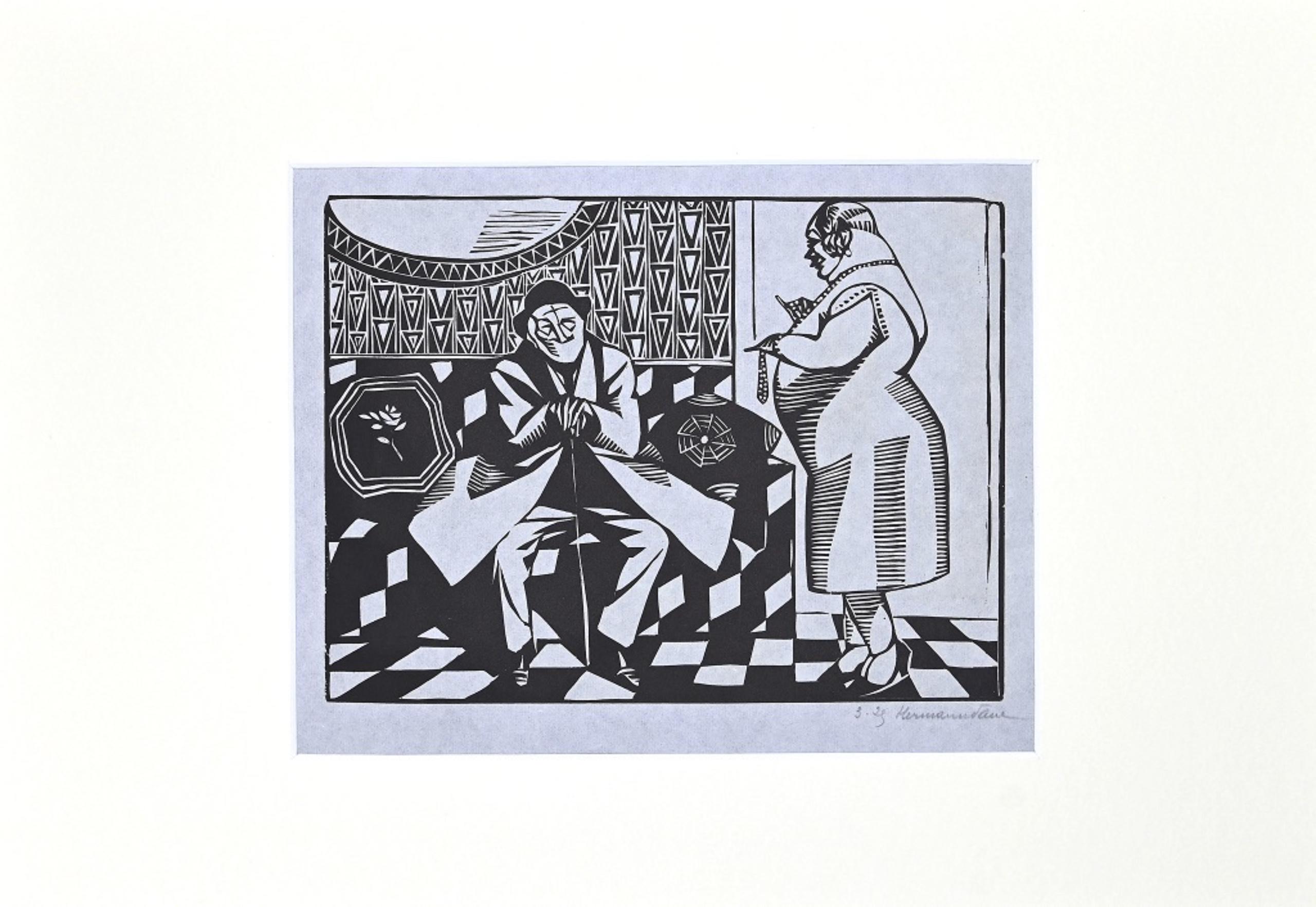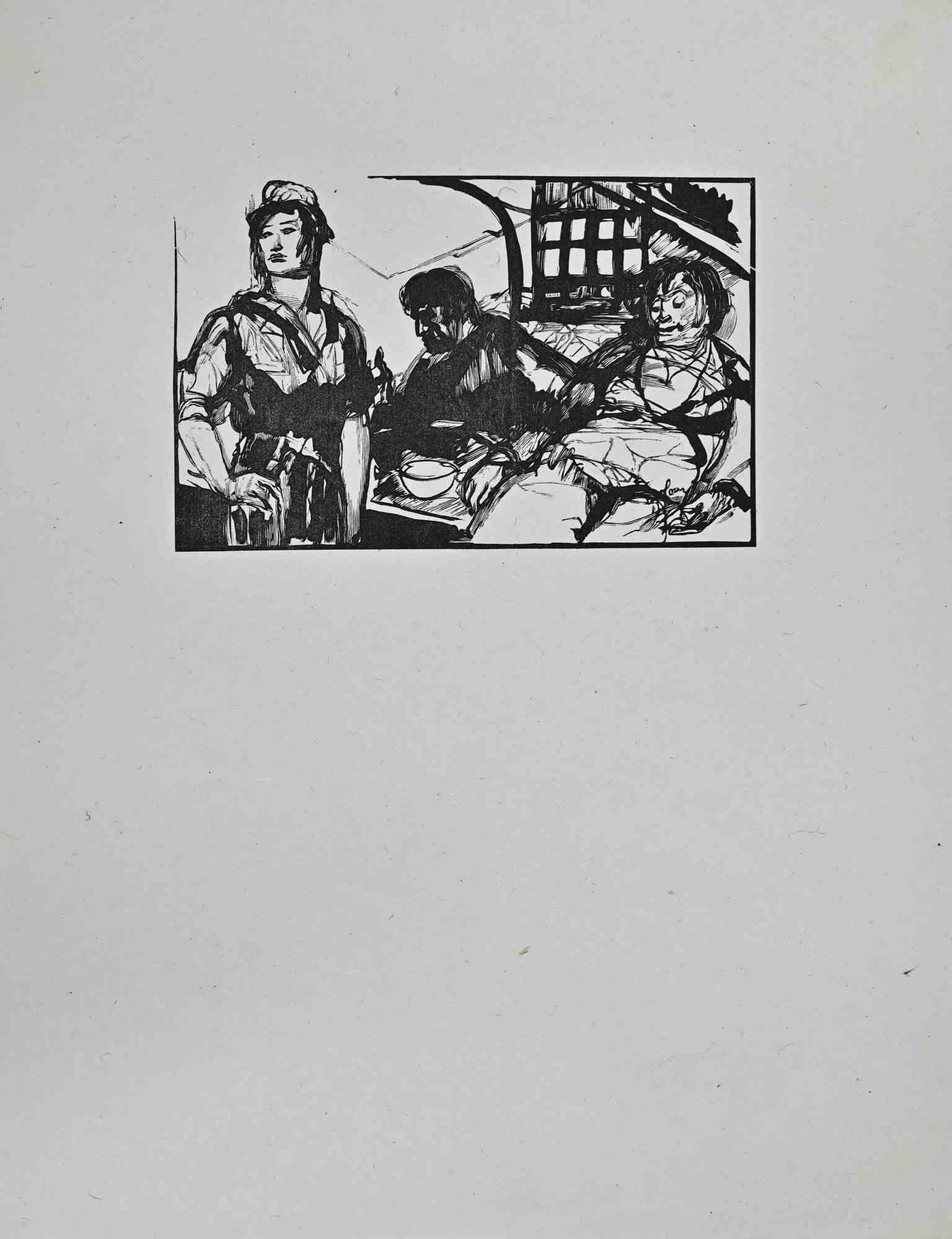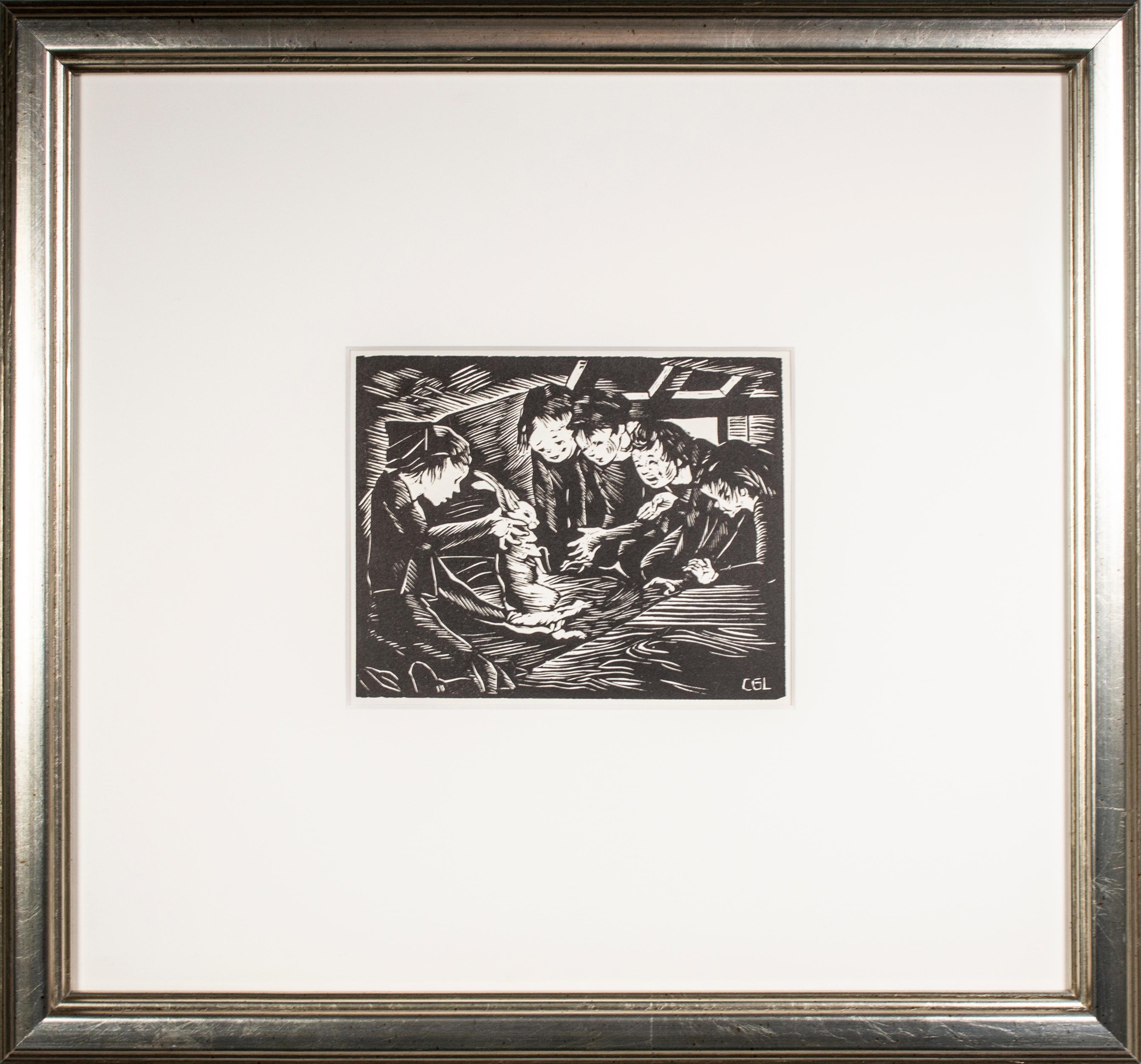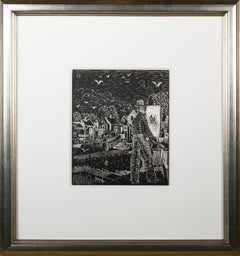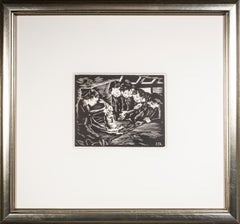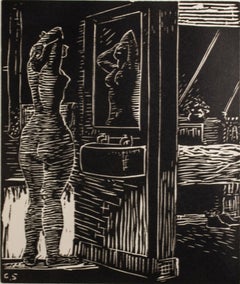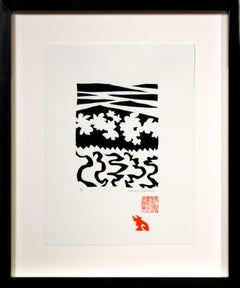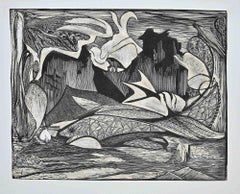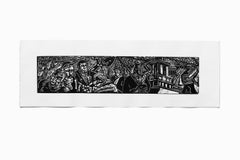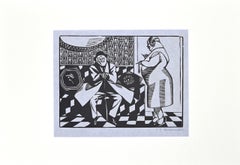Items Similar to 'Monday in Wick Haven' original linoleum cut print by Howard Thomas
Want more images or videos?
Request additional images or videos from the seller
1 of 8
Howard Thomas'Monday in Wick Haven' original linoleum cut print by Howard Thomas1936
1936
$1,300
£1,015.40
€1,151.08
CA$1,863.70
A$2,044.37
CHF 1,069.65
MX$24,332.10
NOK 13,510.30
SEK 12,672.90
DKK 8,596.91
About the Item
In this image, Howard Thomas presents the viewer with a domestic interior. The image is dominated by the figure of a black woman, resting her arm on an ironing board. To the right, the tool of her task dangles a chord above a checker tiled floor. Beyond, though a window, neighboring homes fill the landscape. The careful line-work of the linocut adds a sense of expressionism to the scene, but the image nonetheless falls into the Social Realism that captivated most American artists during the Great Depression.
This print was published in 1936 as part of the Wisconsin Artists' Calendar for the year 1937, which included 52 original, hand-made prints – one for each week of the year.
6 x 5 inches, image
10 x 7.13 inches, sheet
12.37 x 12.43 inches, frame
Entitled "Monday in Wick Haven" lower left (covered by matting)
Inscribed "Linoleum Cut" lower center (covered by matting)
Artist name "Howard Thomas" lower right (covered by matting)
Framed to conservation standards using 100 percent rag matting and museum glass, all housed in a silver gilded moulding.
Quaker-born in Ohio, Thomas trained in the Midwest at Ohio State University and the Chicago Art Institute. He taught in the Art Department of the Milwaukee State Teachers College (now University of Wisconsin-Milwaukee) where he became good friends with Carl Holty, Edward Boerner, Robert von Neumann and Gustave Moeller.
Thomas was a painter of the American scene from the beginning of his career to the mid 1940s. He had been investigating cubism during the mid-to-late 1930s. Thomas made his first trip to the South for a speaking engagement in 1941 and the red earth around Asheville, North Carolina interested him. Thus began his use of earth as a pigment source. In the tradition of old masters, he used mortar and pestle to mix his pigments. Thomas sought natural materials from wherever he traveled around the world and kept a concise diary with painting codes of the gritty earth pigments and dense earth colors for his paintings.
After 1942, Thomas worked permanently in the South. He was an enthusiastic teacher at the University of North Carolina, Greensboro (1942-43), Agnes Scott College, Decatur, Georgia (1943-45) and the University of Georgia where he arranged for Carl Holty, an authority on modern painting, to become artist-in-residence. The “transformation” in Thomas’ painting was the result of interaction with Holty. His progression from regionalist imagery of the 1930s to abstract imagery of the 1950s was done with great deliberation. Thomas gradually eliminated the ideas of foreground and background. Thomas consistently used music as an impetus for his painting. He placed the surface to be painted on the floor and worked with sweeping rhythmic movements to Bach, Vivaldi or Haydn.
Although Thomas painted in the South after 1942, his Milwaukee association had shaped the most important concepts of his intellectual and artistic maturation, especially his exceptional visual memory. He was also a member of the Wisconsin Painters & Sculptors. [Biography via the Museum of Wisconsin Art online archive]
- Creator:Howard Thomas (1899 - 1971, American)
- Creation Year:1936
- Dimensions:Height: 12.37 in (31.42 cm)Width: 12.43 in (31.58 cm)
- Medium:
- Movement & Style:
- Period:
- Condition:
- Gallery Location:Milwaukee, WI
- Reference Number:Seller: 13939g1stDibs: LU60536469662
About the Seller
4.9
Gold Seller
Premium sellers maintaining a 4.3+ rating and 24-hour response times
Established in 1966
1stDibs seller since 2017
452 sales on 1stDibs
Typical response time: 1 hour
- ShippingRetrieving quote...Shipping from: Milwaukee, WI
- Return Policy
More From This Seller
View All'Jones Island' original woodcut engraving by Gerrit Sinclair
By Gerrit Sinclair
Located in Milwaukee, WI
The print 'Jones Island' is something of a self portrait. In the image, an artist stands before and easel, depicting the docks and buildings on the coast. The title indicates that this is Jones Island in Milwaukee, the peninsula along Lake Michigan that today is home to largely industrial buildings. The buildings and figures in the print suggest that this might be a view of the last of the Kashubian or German immigrant settlements on the peninsula before they were evicted in the 1940s to make way for the development of the harbor. The artist in the image thus acts as a documentarian of these peoples. The careful line-work of the woodblock engraving adds a sense of expressionism to the scene, leaving the figures and buildings looking distraught and dirty, though the image nonetheless falls into the Social Realist category that dominated American artists during the Great Depression.
This print was published in 1936 as part of the Wisconsin Artists' Calendar for the year 1937, which included 52 original, hand-made prints – one for each week of the year.
6 x 5 inches, image
10 x 7.13 inches, sheet
13.43 x 12.43 inches, frame
Signed "GS" in the print block,upper left
Entitled "Jones Island" lower left (covered by matting)
Inscribed "Wood Engraving" lower center (covered by matting)
Artist name "Gerrit V. Sinclair" lower right (covered by matting)
Framed to conservation standards using 100 percent rag matting and museum glass, all housed in a silver gilded moulding.
Gerrit Sinclair studied at the Art Institute of Chicago from 1910 - 1915, under Vanderpoel, Norton, and Walcott. In World War I, he served in the Army Ambulance Corps and later recorded his experiences in a series of oil paintings. He taught in Minneapolis before arriving in Milwaukee in 1920 to become a member of the original faculty of the Layton School of Art. He was also a member of the Wisconsin Painters & Sculptors.
Sinclair's paintings and drawings were executed in a lyrical, representational style, usually expressing a mood rather than a narrative. His paintings reveal a great sensitivity for color and atmosphere. His subject matter focused on cityscapes, industrial valleys, and working-class neighborhoods, captured from eye-level. A decade before the popularity of Regionalism, Sinclair's strong interest in the community was reflected not only in his paintings, but also in his encouragement to students to return to their communities as artists and teachers. Joseph Friebert...
Category
1930s American Modern Figurative Prints
Materials
Woodcut, Engraving
'The Rabbit' original woodcut engraving by Clarice George Logan
By Clarice George Logan
Located in Milwaukee, WI
In 'The Rabbit,' Wisconsin artist Clarice George Logan presents the viewer with a multi-figural scene: under a wood-frame structure, four children crouch on the ground, gathered around a young woman who presents a rabbit. Under normal circumstances, such an image of children with a bunny would recall childhood storybooks. In this case, however, the image is more ambiguous and suggests the unfortunate economic circumstances many children suffered during the interwar years. Nonetheless, the group could also be interpreted as a nativity play, with the rabbit taking the place of the Christ child, shining light on the children like in a painting by the Italian Renaissance artist Correggio. The careful line-work of the woodblock engraving adds a sense of expressionism to the scene, leaving the figures looking distraught and dirty, though the image nonetheless falls into the Social Realist category that dominated American artists during the Great Depression.
This print was published in 1936 as part of the Wisconsin Artists' Calendar for the year 1937, which included 52 original, hand-made prints - one for each week of the year.
Clarice George Logan was born in Mayville, New York in 1909 but moved to Wisconsin in 1921. She attended the Milwaukee State Teachers College from 1927 to 1931 where she studied with Robert von...
Category
1930s American Modern Figurative Prints
Materials
Engraving, Woodcut
"Figure, " Nude Portrait Linoleum Cut by Gerrit Sinclair
By Gerrit Sinclair
Located in Milwaukee, WI
"Figure" is an original linoleum print by Gerrit Sinclair, signed in plate the lower left corner. It features a woman fixing her hair in front of a mirror, her nude body visible to the viewer from the back and front reflecting in the mirror.
Image: 6" x 5"
Framed: 13.37" x 12.43"
Gerrit Sinclair brought the charming style of American Regionalism painting...
Category
1930s American Realist Figurative Prints
Materials
Linocut
'Field' original abstract linocut in black by Wisconsin artist Schomer Lichtner
By Schomer Lichtner
Located in Milwaukee, WI
'Field' is an original linocut by Wisconsin-based artist Schomer Lichtner. The composition presents fields of flowers, trees and grasses below a cloudy sky, but rendered with Lichtner's quintessential abstract sensibilities. This print is one from a series that each depict abstracted subjects in black silhouette, taking pleasure in the materiality of the linocut technique. The free forms of the plants resemble the lyrical mid-century works of the French artist Henri Matisse, which combined with these material concerns demonstrate Lichter's modern sensibilities. The prints from this series are unusual because of how below the image, Lichtner also includes his Chinese seal and a linocut remarque of a cow, each of which act as an additional signature of the artist on the artwork.
Linocut in black and red on Permalife white wove paper
4.5 x 6 inches, image
11.5 x 8.75 inches, sheet
16.5 x 13.63 inches, frame
Signed in pencil, below image, lower right.
Edition 1/100 in pencil, below image, lower left.
Chinese signature stamp in red, below image, lower right.
Remaque of a cow in red, below image, lower right.
Permalife watermark to paper.
Framed to conservation standards in a shadow-box style mounting, using 100 percent rag matting, museum glass, and housed in a silver-finish wood moulding.
Overall excellent condition with no creases or discoloration.
Milwaukee artist Schomer Lichtner was well known for his whimsical cows and ballerinas and abstract imagery. He and his late wife Ruth Grotenrath, both well-known Wisconsin artists, began their prolific careers as muralists for WPA projects, primarily post offices.
Lichtner also painted murals for industry and private clients. Schomer was a printmaker and produced block prints, lithographs, and serigraph prints. His casein (paint made from dairy products) and acrylic paintings are of the rural Wisconsin landscape and farm animals. He became interested in cows when he and Ruth spent summers near Holy Hill in Washington County. According to David Gordon, director of the Milwaukee Art Museum, Schomer Lichtner had a tremendous joie de vivre and expressed it in his art.
Schomer Lichtner was nationally known for his whimsical paintings and sculptures of black- and white-patterned Holstein cows...
Category
Late 20th Century American Modern Landscape Prints
Materials
Black and White, Paper, Linocut
"Meditation, " Figure & Farm Tool Linoleum Cut signed by Schomer Lichtner
By Schomer Lichtner
Located in Milwaukee, WI
"Meditation" is an original linoleum print by Schomer Lichtner, signed in the lower right hand corner. It features a man in the middle of a project, in quiet meditation.
Image: 6" x 8"
Framed: 14.5" x 14.37"
Lichtner and his wife, Ruth Grotenrath (1912-1988), are celebrated as Milwaukee’s first couple of painting and are regarded as major Wisconsin artists. Lichtner’s impressive production, perseverance, longevity, and positive approach to his life and art made him and his work distinctive and much loved by his many admirers. His work is currently represented in collections at the Milwaukee Art Museum, the John Michael Kohler Art Center, the West Bend Museum, and in the collections of many individuals. Books on the lives and art work of both Lichtner and Grotenrath are in progress and it is anticipated that they will be published next year. Recipient of the 2006 Wisconsin Visual Artist Lifetime Achievement Award The late Milwaukee artists, Schomer Lichtner and Ruth Grotenrath, created original silkscreen prints as a part of their Christmas celebration starting in the 1940's. The subjects and colors varied from year to year but they laboriously printed these little gems themselves. Ruth Grotenrath, 1912-1988, and her husband, Schomer Lichtner, (1905-2006), are celebrated as Milwaukee’s first couple of painting and are regarded as major Wisconsin artists. From the outset, Lichtner and Grotenrath were determined to become full-time artists. Ruth Grotenrath and Schomer Lichtner began their careers by creating numerous murals for the WPA (Work Projects Administration), primarily post offices. A wonderful example can be seen in the Sheboygan, Wisconsin post office. Even during the Great Depression they worked producing Post Office murals under the Treasury Department's Section of Fine Arts (SFA). According to James Auer, former Milwaukee Journal Sentinel art critic, "As art and economic trends evolved, the couple’s palettes brightened and warmed. Both fell under the spell of the Mexican social realists, notably Diego Rivera, and modernists such as Matisse and Dufy. The couple’s perspective changed further after they became friends with philosopher Alan Watts...
Category
1930s American Modern Figurative Prints
Materials
Linocut
"Swimmers, " Seascape Linoleum Cut by Clarice George Logan
By Clarice George Logan
Located in Milwaukee, WI
"Swimmers" is an original linoleum print by Clarice George Logan. It features five figures enjoying a swim, jumping off from a small boat.
Image: 4.94" x 6"
Framed: 13.87" x 14.87"
Clarice George Logan was born in Mayville, New York in 1909 but moved to Wisconsin in 1921. She attended the Milwaukee State Teachers College from 1927 to 1931 where she studied with Robert von Neumann...
Category
1930s American Modern Figurative Prints
Materials
Linocut
You May Also Like
Composition - Original Woodcut Print By Madeleine Flaschner - Late-20th Century
Located in Roma, IT
Composition is an Original Woodcut realized by Madeleine Flaschner (1933-....).
The artwork is an experience greatly enhanced by the artist.
Mono...
Category
19th Century Modern Figurative Prints
Materials
Woodcut
"History of Detroit" Linoleum Cut, Black Ink, African American, Mural Style
By Hubert Massey
Located in Detroit, MI
"History of Detroit" is in the style of a mural by the master muralist from the city of Detroit, Hubert Massey. It renders in dramatic composition the ov...
Category
Early 2000s American Modern Figurative Prints
Materials
Linocut
The Wait - Woodcut Print by Hermann-Paul - 1925
Located in Roma, IT
The Wait is an original Modern artwork realized by Hermann-Paul (Paris,1864 – 1940).
Original Woodcut on paper.
Hand-signed in pencil on the lower right corner.
Passepartout is i...
Category
1920s Modern Figurative Prints
Materials
Woodcut
The Rest and Wait - Woodcut Print by Paul Baudier - 1930s
Located in Roma, IT
The Rest and Wait is a woodcut print on ivory-colored paper realized by Paul Baudier (1881-1962) in the 1930s.
Good conditions.
Paul Baudier, (born October 18, 1881 in Paris and di...
Category
1930s Modern Figurative Prints
Materials
Woodcut
Contemporary Landscape Linoleum Block Print, "Homage"
Located in San Diego, CA
This is a one of a kind original Linoleum block print piece by San Diego artist, Duke Windsor. It is a framed landscape piece and its dimensions a...
Category
2010s Contemporary Landscape Prints
Materials
Woodcut
"The Engraver" Double Layer Woodblock Print
Located in Soquel, CA
Bold woodcut print by M. Sheppard (20th Century). This piece is filled with Neolithic imagery of people and animals. There are two figures that are engaged in hunting and several pre...
Category
1980s Other Art Style Figurative Prints
Materials
Paper, Ink, Woodcut
More Ways To Browse
Rolf Weijburg
Roy Lichtenstein Hopeless
Roy Lichtenstein Pyramids
Ruth Starr Rose
Ryan Hewett
S L Margolies
Salvador Dali Bull
Salvador Dali Fallen Angel
Salvador Dali Fashion Designer
Salvador Dali Hamlet
Salvador Dali Jesus On The Cross
Salvador Dali Judah
Salvador Dali Paradise 6
Salvador Dali Paradise Lost
Salvador Dali Purgatory 1
Salvador Dali Self Portrait
Salvador Dali Signature
Salvador Dali Signed Paradise
